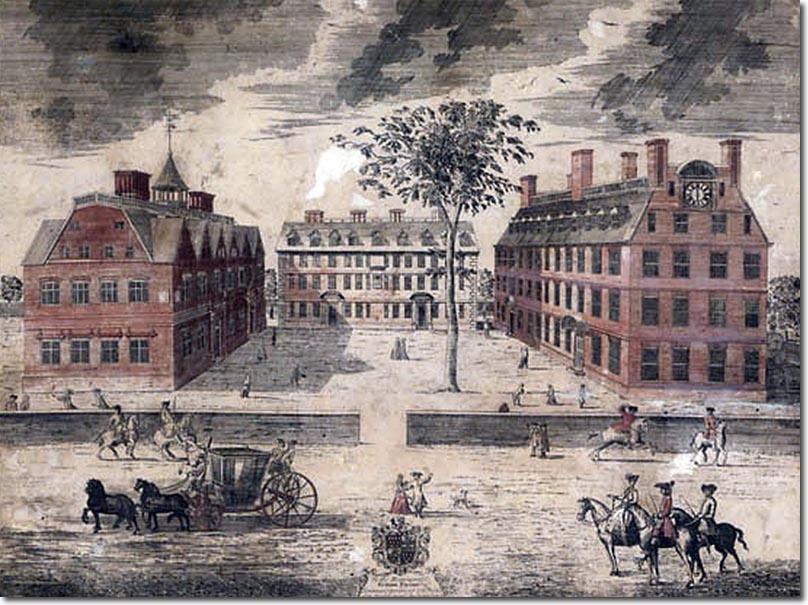THE ORIGINS OF YALE UNIVERSITY

Harvard University in 1726
At this point our story reverts to New Haven and Connecticut, and the process by which Elihu Yale gave his name to the university.
The Puritans in New England had decided to establish a college in Cambridge, just across the Charles River from Boston. The first master was Theophilus Eaton's brother, Nathaniel. It was called 'Harvard' after Rev John Harvard, who may have come over on the same boat in 1637 as the Eatons and the Yales. He had died soon afterwards leaving his library and half his estate to the new college, which was established for 'the education of the English and Indian youth of this country in knowledge and godliness' by an Act of Parliament passed under the Commonwealth in 1650.
After the Restoration, however, the exclusively Puritan character of the New England colonies came under attack from Charles II and James II, who wished to bring the area under tighter royal control and to provide more scope for the promotion of the episcopal Church of England. One of the leaders of the opposition to this was Rev Increase Mather. Mather was also opposed to tendencies within the Puritan churches who wanted to ease the terms of communion, in particular the need to provide convincing proof of an experience of saving grace.
In 1681-2, Mather was Acting President of Harvard. He became Rector in 1685, and continued in this position until 1701, but in 1688 he eluded capture at the hands of James II's energetic governor of New England, Sir Edmund Andros, and escaped to England, where he argued the colony's case with little success while James II was still King. After the Revolution he secured a new charter for the colony but from his own point of view it was unsatisfactory. The rights of citizenship were made dependent on property not, as previously, on approval by the clergy.
While Increase Mather was still in England, the people of Massachussets were celebrating their freedom from James' tyranny by indulging in the great Salem witchcraft hysteria, the subject of Arthur Miller's play The Crucible. 200 people were accused, 150 imprisoned, 19 hanged and one pressed to death. The trials were instigated by Increase Mather's son, Cotton Mather, who celebrated the whole affair in his book The Wonders of the Invisible World. Increase took command of Harvard College on his return and he and Cotton worked closely together as joint ministers of the church in Boston.
Through the 1690s, the Mathers encountered a growing movement among the New England community opposed to the practice of confining Communion to 'visible saints' who could give proof of the signs of salvation in their hearts. One of the strongholds of the new movement was Harvard College. It included John Leverett and Ebenezer Pemberton, tutors in the college, Thomas Brattle, the college treasurer, and William Brattle, minister of the church in Cambridge. Thomas Brattle was involved in the formation of a new church in Boston based on these principles, nicknamed the 'Manifesto Church' because of a manifesto issued by its pastor, Benjamin Colman. Colman had been ordained in London, 'his friends anticipating the difficulty of procuring the ceremony to be performed in Boston.'
In 1700/01 the quarrel took the form of an exchange of pamphlets. Joseph Quincy in his History of Harvard University says of one of the pamphlets, published anonymously but almost certainly written by Cotton Mather, that 'In the whole scope of theological and political controversy, there is scarcely an example extant, of more select, concentrated and unmixed personal abuse than is exhibited in this pamphlet and its preface.' For anyone familiar with theological polemical literature, that is a remarkable claim.
In 1701, after a long controversy with the council, Increase Mather was ousted from the presidency. The pretext was his refusal to leave his congregation in Boston and settle permanently in Cambridge but since his successor did not live permanently in Cambridge either it was obvious that this was not the real reason. It was in this context that a meeting was held in 1700 to form a new college in Connecticut - initially at Saybrook. One of the leading promoters of the new college was Rev James Pierpont, minister of the church in New Haven, a successor to the Rev John Davenport who, over fifty years previously, had excommunicated Elihu Yale's grandmother, Anne Eaton. Rev James Pierpont was a close friend of Cotton Mather.